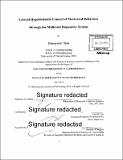Lateral hypothalamic control of motivated behaviors through the midbrain dopamine system
Author(s)
Nieh, Edward H. (Edward Horng-An)
DownloadFull printable version (15.37Mb)
Alternative title
LH control of motivated behaviors through the midbrain dopamine system
Other Contributors
Massachusetts Institute of Technology. Department of Brain and Cognitive Sciences.
Advisor
Kay M. Tye.
Terms of use
Metadata
Show full item recordAbstract
The lateral hypothalamus and ventral tegmental area are two brain regions that have long been known to be involved in processing reward and the control of feeding behaviors. We continue work in this area by identifying the functional connectivity between these two regions, providing evidence that LH neurons projecting to the VTA encode conditioned responses, while LH neurons innervated by the VTA encode conditioned and unconditioned stimuli. Activation of the LH-VTA projection can increase compulsive sugar seeking, while inhibition of the projection can suppress this behavior without altering normal feeding due to hunger. We can separate this projection into the GABAergic and glutamatergic components, and we show that the GABAergic component plays a role in promoting feeding and social interaction by increasing motivation for consummatory behaviors, while the glutamatergic component largely plays a role in the suppression of these behaviors. Finally, we show that activation of the GABAergic component causes dopamine release downstream in the nucleus accumbens via disinhibition of VTA dopamine neurons through VTA GABA neurons. Together, these experiments have profoundly elucidated the functional roles of the individual circuit components of the greater mesolimbic dopamine system and provided potential targets for therapeutic intervention of overeating disorders and obesity..
Description
Thesis: Ph. D. in Neuroscience, Massachusetts Institute of Technology, Department of Brain and Cognitive Sciences, 2016. Cataloged from PDF version of thesis. Includes bibliographical references (pages 209-231).
Date issued
2016Department
Massachusetts Institute of Technology. Department of Brain and Cognitive SciencesPublisher
Massachusetts Institute of Technology
Keywords
Brain and Cognitive Sciences.